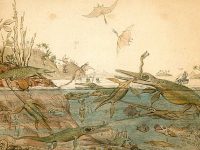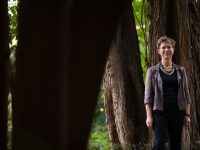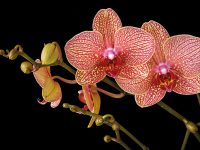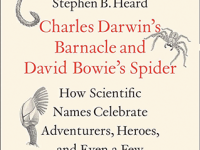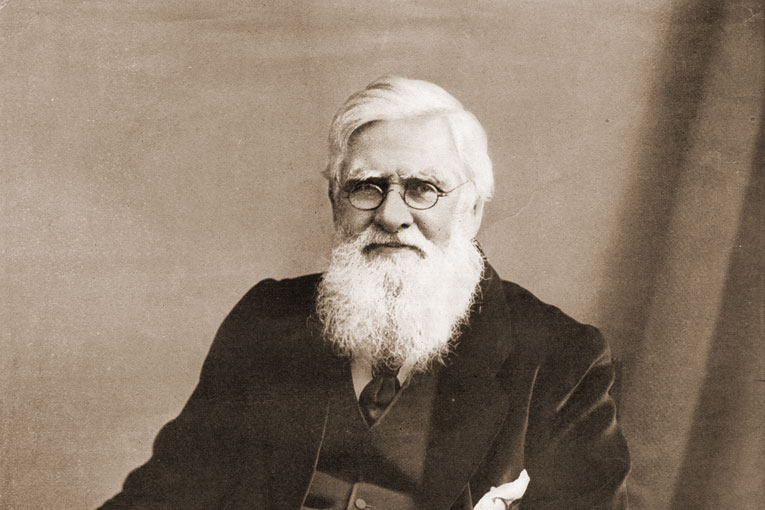
A slow yet extremely reflexive writer
We have to recognise it: without Alfred Russel Wallace (1823-1913), Darwin may have never published The Origin of Species. Retired in his house in Down, near London, Darwin puzzled over the problem of the formation of species since he came back from the journey on the Beagle, more than twenty years before. His observations clearly indicated that species evolved, transformed into new species, yet he was not sure of what could be the mechanism that made such transformations possible. Darwin was a slow, reflexive writer, who rejected hypothesising without a maximum amount of evidence to support it. In addition, he knew his ideas on the origin of species in general, and of mankind in particular, would arouse controversy in Victorian society, and he did not want to throw more fuel into the fire.
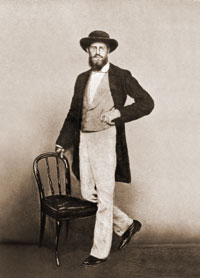
Alfred Russel Wallace, in Singapore, in 1862, jus before coming back to the United Kingdom after eight years in the Malay Archipelago./ A. R. Wallace Memorial Fund & G. W. Beccaloni
It is true that in 1842 he wrote a 37-page draft (the famous Sketch), hurriedly and in pencil, with unfinished sentences, an irregular structure and a lot of corrections and crossing-outs, but in which we can find the first ideas on the evolution of species and the possible mechanisms governing it. It is also true that two years later, in 1844, he wrote a 189-page manuscript, a lot tidier and more careful, gathering his conclusions at the moment, and it bears some resemblance with what would later be The Origin of Species (De Beer, 1958). It is fair to say that the manuscript (known by Darwinians as the Essay) served as a kind of insurance in case he did not finish the final version, «the big book» to which he aspired, the one he wrote ever so slowly. It is moving to see the long letter concerning the Essay that Darwin sent Emma, his wife, on July 5, 1844, in which he writes: « I therefore write this, in case of my sudden death, as my most solemn & last request, which I am sure you will consider the same as if legally entered in my will, that you will devote 400£ to its publication & further will yourself, or through Hensleigh, take trouble in promoting it». Apart from touching, the letter states much about the importance, conceptual and «strategic», he attributed to the Essay at the moment.
A first warning from Wallace
One of Darwin’s best friends was Charles Lyell, geologist and one of the most influential naturalists in England at the time, who insisted that Darwin should write his final theory once and for all, even if he did not have all the answers. A key event transpired in 1855, when Lyell read a work published by an obscure naturalist, Alfred Russel Wallace, who was at the Malay Archipelago at the time professionally collecting animals and plants. The name of the work was On the Law which Has Regulated the Introduction of New Species, and it was based on observation suggesting that «Every species has come into existence coincident both in space and time with a pre-existing closely allied species». In this work, known as the Sarawak document, he highlighted the importance of extinction and modified offspring –divergence– as key elements in the process of species transmutation through time. Lyell clearly saw that Wallace was steeply entering the field that had occupied Darwin for more than twenty years, and warned him (Davies, 2013). Darwin read the document, but gave no importance to it, and wrote in the margins: «Nothing very new […]; it seems all creation with him […]; his law hold good; he puts the facts in striking point of view», maybe because Wallace profusely used the term «creation» instead of «transmutation», which was the word in use at the time to talk about the formation of species. He ascribed no importance to it, but due to Lyell’s persistence, he resumed the writing of his book, which he would never finish because of the events that occurred two years later.
The Ternate essay arrives
In early June 1858, Darwin received a manuscript and a letter from Wallace from the small island of Ternate, in the Malay Archipelago. The manuscript bore a suggestive name: On the Tendency of Varieties to Depart Indefinitely from the Original Type, and proposed a certain variability between the individuals of the same species. It also suggested that the variations that better adapted to the environment would have more possibilities of surviving and breed, and would separate from the original species until they became a different one.
«When Darwin received the Ternate essay, he started to be seriously concerned about priority»
To be clear, it was a theory that explained the origin of species thanks to natural selection. In the letter coming with the manuscript, Wallace asked Darwin, if he found it interesting, to introduce him to Lyell to know his opinion on the matter before publishing. Darwin was paralysed, because the Ternate essay contained the formal development of his own ideas on the origin of species, growing constantly since he came back from his journey on the Beagle. He himself expressed that the manuscript was a good summary of the work he had been doing for the last twenty years.
But who was Wallace?
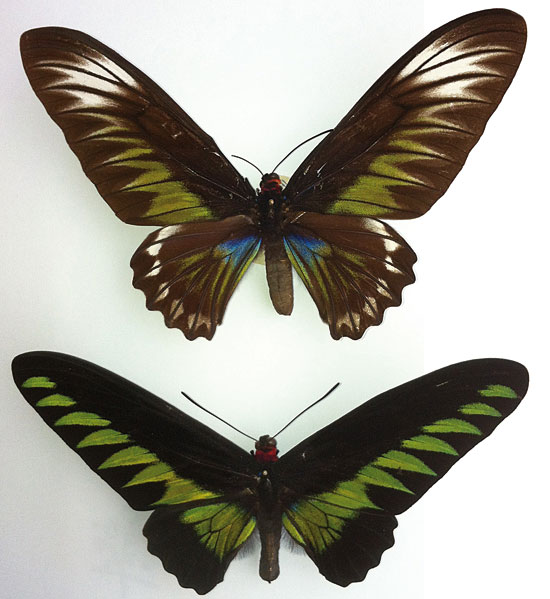
Male (bottom) and female of the butterfly Trogonoptera brookiana (Wallace, 1855) (Lepidoptera, Papilionidae), discovered in Borneo by Wallace and dedicated to the British Rajáh of Sarawak, James Brooke. Wallace described it in the Ornithoptera genus and it is one of the most beautiful butterflies in the world. The specimens in the photo come from the Cameron Highlands, in Malaysia.
Alfred Russel Wallace was born on January 8, 1823 in Usk, southeast Wales, to a medium-class family with limited resources. When he was twelve, he left school to go to London to work as a carpenter with his brother John. A year later, he started working with another brother, William, first as a clock-maker in training, then as a topographer and field supervisor for the railway. The job taught him to draw maps, design buildings, mechanics, forestry techniques and many other skills that would prove very useful in the following years. He spent seven years in the job, in close contact with nature, and perhaps developed an interest on natural history. In 1842, he read the book Treatise on Geography and Classification of Animals, by W. Swainson, which introduced him to biogeography. Wallace admitted later that reading the book was the starting point of his scientific inclination. In 1844 he moved to Leicester to teach drawing and cartography. In Leicester library he read An Essay on the Principle of Population, by Malthus, and met Henry Walter Batas, enthusiast entomologist who introduced him to the world of beetles and butterflies. A year later, due to the death of his brother William, he had to take charge of his land supervision business, which nevertheless closed very soon. 1845 was a year of important readings, like the work of R. Chambers Vestiges of the Natural History of Creation, which turned him, in his own words, into an «evolutionist», Lyell’s Principles of Geology or Darwin’s journey of the Beagle. In 1847 he travelled to Paris with his sister Fanny and visited the great zoological collections of the Jardin des Plantes. When he came back, he visited the British Museum, and decided to devote his life to natural history. He spoke to Bates, and they decided to head for the Amazonia, sponsored by Samuel Stevens, who offered to sell the animals and plants they found to museums and private collections.
«With the available evidence, it is out of place to charge Darwin with copying Wallace»
On April 26, 1848, they set sailed from Liverpool and headed for Brazil, and on May 26th they arrived to Pará, currently Belém. He spent four years of hard learning in the Amazon, which he narrated in his book A Narrative of Travels on the Amazon and Rio Negro. The end of the journey was the loss of his collections and diaries when the ship bringing him back home was shipwrecked in the middle of the Atlantic. The experience was so hard on him that he promised to himself upon his arrival to London not to carry out the job again. Two years later, however, he embarked on a ship for the Malay Archipelago, where he stayed for eight years during which he discovered an amazing number of species that were new for science and gathered an enormous volume of data about the distribution of animals and plants (McKinney, 1972; Raby, 2001; Wallace, 1905). It was there that he had the idea of the mechanism of natural selection, and sent Darwin the famous Ternate essay.
The meeting of the Linnean Society
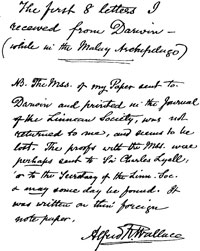
Wallace kept the letters fromn Darwin. The picture shows the envelope where he kept eight letters received in the Malay Archipelago./ Natural History Museum, London
When Darwin received the Ternate essay, he started to be seriously concerned about priority, and asked for advice, first from Lyell and then from botanist Joseph Hooker, also a very influential individual. Lyell and Hooker plotted a plan that allowed for the release of Wallace’s work but left no room for any doubt on the fact that Darwin had already been thinking of the same questions for years. In just twelve days they organised a joint reading of Darwin and Wallace’s works in the Linnean Society of London, in a science session on July 1, 1858. The order of the presentations was meticulously planned so that Darwin’s priority was perfectly established. A small introductory note by Lyell and Hooker gave way to the reading of both documents: the first, a summary of the famous Essay Darwin had written in 1844; then, a letter sent by Darwin to the North-American naturalist Asa Gray in 1857, in which he commented on the principle of divergence between variations of the same species; and in the third place the Ternate essay sent by Wallace (Raby, 2001). None of the authors attended the session: Darwin was in the funeral of his son Charles Waring, who died three days before; and Wallace because he was in New Guinea. The session came and went without a fuss, reviewed only by Samuel Houghton, of the Trinity College in Dublin, who diagnosed that « all that [was] new in there was false, and what was true was old». A poor review to describe one of the most sensational discoveries in science history: the mechanism that governs evolution of the living world. A discovery both Darwin and Wallace had made independently.
The date controversy
A very controversial issue is the date in which the letter and manuscript left Ternate, and the date they arrived to Darwin’s home in Down. It is well known that Wallace wrote the essay towards the end of February 1858, after a serious attack of malaria. In different retrospective texts, Wallace states that he wrote the document a couple of days after the disease and sent it to Darwin «with the next mail, one or two days later» (Wallace, 1905). With the same mail, which departed from Ternate on March 9, 1858, there was a letter for the brother of his friend Henry Bates, who lived in Leicester. As we already said, Darwin, restless due to the Ternate essay, wrote a letter to Lyell asking for advice on the matter. The letter is dated on June 18, and he said he received the essay that same day.
The controversy starts here, because we certainly know that the letter Wallace sent to Bates’ brother left Ternate on March 9, reached London on June 2 and Leicester the day after. The one sent to Darwin should, then, have arrived to London and a day later to Down, as some historians maintain –namely McKinney (1972), Brackman (1980) and Davies (1008). The polemic was revived recently with van Wyhe and Rookmaaker’s hypothesis (2012) (also van Wyhe, 2013), which postulates that Wallace’s letter would not have left Ternate on March 9, but with the next mail, on April 5, so it would have arrived to Down on June 18. However, the hypothesis is considered unlikely because of several reasons, particularly because of inconsistencies in timetables and letter transport in the mail system of the time, and because of Wallace’s repeated claim that he sent the essay soon after he wrote it in late February (Davies, 2013; Smith, 2013).
«Wallace distanced himself from Darwin scientifically, essentially because he started expressing theological ideas about nature»
If Wallace’s letter and essay had reached Darwin on June 3, why did he not contact Lyell until June 18? It is a difficult question to answer, but Wallace’s supporters consider very significant the fact that Darwin added, from June 3 to June 15, 66 pages about divergence, so commented upon in the Ternate essay, to the big book he was writing (Brooks, 1984). Could Darwin have received the manuscript before the date he stated in his letter to Lyell, and did he borrow ideas from it concerning divergence during the time he held it? It is a possibility, but seems really far-fetched considering Darwin’s moral rectitude. Almost certainly Darwin took inspiration from Wallace’s concepts, for instance the ones in the Sarawak document –later, though–, it is also true that thanks to Wallace he included to his concept corpus important knowledge such as the geographical distribution of animals and plants. On the other hand, it seems evident that the Ternate essay was the trigger for Darwin to establish a program for the publication of his ideas. Nonetheless, with the available evidence, it is out of place to charge Darwin with copying Wallace, as Davies (2008) does when he claims the ideas in the Ternate essay were plagiarised by Darwin, and asserts that the issue is «a deliberate and iniquitous case of intellectual theft, deceptions and falsehood committed by Darwin». Probably Wallace, who always showed the uttermost respect and unconditional affection towards Darwin, would not like to hear these words.
Wallace, more Darwinist than Darwin
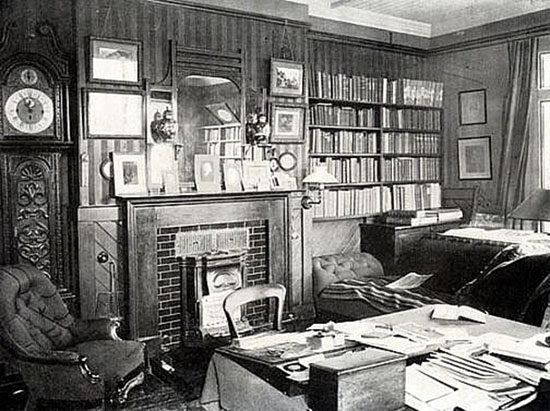
Wallace’s study at his last home in Old Orchard, Broadstone (Dorset), where he lived from Christmas 1902 to his death in November 1913. The study bears a resemblance with Darwin’s one in Down House./ A. R. Wallace Memorial Fund & G. W. Beccaloni
Whatever the case may be, Lyell and Hooker’s staging registered Wallace’s merit, yet clearly favoured Darwin. The next year, under Lyell’s insistence, Darwin would publich The Origin of Species, the work that would establish him as the father of evolution by natural selection. Regarding Wallace, in the autumn of 1858 he would receive in Ternate two letters by Hooker and Darwin describing the procedure through which his works had been published together with Darwin’s in the Linnean Society. In October of the same year Wllace wrote Mary, his mother, to proudly tell her that they put him at the same level as Darwin, ensuring «the support of these eminent sirs when I go back home». For the rest of his life, Alfred Wallace would be Darwin’s most fervent supporter, more Darwinist than Darwin himself.
In spite of everything, it is true that Wallace distanced himself from Darwin scientifically, essentially because he started expressing theological ideas about nature, especially concerning man’s evolution, suggesting it was guided by a higher intelligence and governed by laws more important than natural selection. In a letter sent in January 1870, Darwin reprimanded him («you write like a metamorphosed (in retrograde direction) naturalist, and you the author of the best paper that ever appeared in the Anthropological Review! Eheu! Eheu! Eheu!»), but they were always in respectful and friendly terms (Raby, 2001).
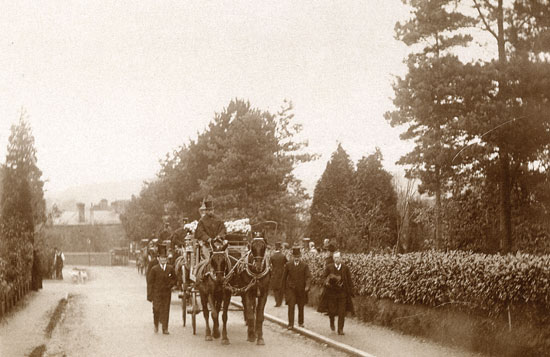
Alfred Wallace’s burial. Everyone agrees that he kept busy into his nineties, and was only weak the last months of his life. He died in his sleep at home in Broadstone (Dorset)./ Memorial Fund & G. W. Beccaloni
Wallace died at 90 years old, and for the more than fifty years after the joint presentation in the Linnean Society he published many books, among which the excellent journey account The Malay Archipelago, 1869, stands out thanks to popular acceptance; as well as The Geographical Distribution of Animals, because of its impact on the scientific community. The last one places him as the father of biogeography, highlighting his identification of the border between the Eastern and Australian faunal region, the Wallace line, which crosses the Malay Archipelago crossing between the islands of Balin and Lombok. Or numerous essays, the most important of which were collected in the books Contributions to the Theory of Natural Selection (1870), Tropical Nature and Other Essays (1878) or Darwinism (1889). Apart from these important scientific works, he devoted a lot of time to defend the study of spiritualism, to political issues from a little particular socialist point of view, and to other social issues, such as his rejection to vaccination campaigns. All of this earned him an ambiguous reputation and quite a lot of problems with scientists. All in all, it was clear that his scientific achievements far outweighed his incursions in those slippery grounds, and he received a lot of perfectly-deserved honours. For instance the Royal Society Medal in 1868, the Darwin Medal in 1890, the Royal Geographical Society’s Founder’s Medal in 1892, the Linnean Society’s Gold Medal in 1892 and the Copley Medal in 1908. In 1893 he was chosen Royal Society member, and the Linnean Society established in 1908 the Darwin-Wallace Medal, to commemorate the fifty years of their 1858 presentation (the first one was naturally gave to Wallace). It should be noted also that the British government granted him an allowance of 200 pounds a year in 1881, promoted by Darwin with the support of Hooker (Raby, 2001). The letter Darwin sent to Wallace on January 7, 1881 to tell him about it is very touching. He expected it would give him « hope that it will give you some satisfaction to see that not only every scientific man to whom I applied, but that also our Government appreciated your lifelong scientific labour».
When Wallace died on November 7, 1913, at home in Broadstone, Dorset, some of his friends suggested he was buried in the Westminster Abbey. However, his wife Annie had him buried in the small cemetery of Broadstone, following his last will. In 1915, a commission of prominent British scientists suggested to place a commemorative plaque of Wallace in the Abbey, near the place where Darwin was buried. The plaque was finally set and inaugurated on November 1, 1915. The two fathers of the mechanism of natural selection reunited again, although symbolically.
REFERENCES
Brackman, A. C., 1980. A Delicate Arrangement: the Strange Case of Charles Darwin and Alfred Russel Wallace. Times Books. New York.
Brooks, J. L., 1984. Just Before the Origin: Alfred Russel Wallace’s Theory of Evolution. Columbia University Press. New York.
Davies, R., 2008. The Darwin Conspiracy: Origins of a Scientific Crime. Golden Square books. London.
Davies, R., 2012. «How Charles Darwin Received Wallace’s Ternate Paper 15 Days Earlier than He Claimed: a Comment on Van Wyhe and Rookmaaker». Biological Journal of the Linnean Society,105: 472-477.
Davies, R., 2013. «1 July 1858: What Wallace Knew; What Lyell Thought He Knew; What Both He and Hooker Took on Trust; and What Charles Darwin Never Told Them». Biological Journal of the Linnean Society,109: 725-736.
De Beer, G., 1958. Charles Darwin and Alfred Russel Wallace: Evolution by Natural Selection. Cambridge University Press. Cambridge.
McKinney, H. L., 1972. Wallace and Natural Selection. Yale University Press. New Haven, CT.
Raby, P., 2001. Alfred Russel Wallace: a Life. Chatto & Windus. London.
Smith, Ch. H., 2013. «A Further Look at the 1858 Wallace–Darwin Mail Delivery Question». Biological Journal of the Linnean Society,108: 715-718.
Wallace, A. R., 1905. My life: a Record of Events and Opinions. 2 vols. Chapman & Hall. London.
Wyhe, van J. and K. Rookmaaker, 2012. «A New Theory to Explain the Receipt of Wallace’s Ternate Essay by Darwin in 1858». Biological Journal of the Linnean Society,105: 249-252.
Wyhe, van J., 2013. Dispelling the Darkness: Voyage in the Malay Archipelago and the Discovery of Evolution by Wallace and Darwin. World Scientific. Singapore.

